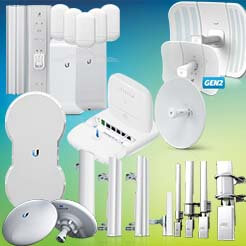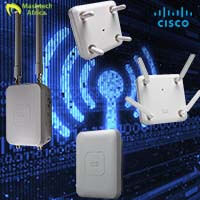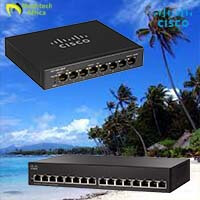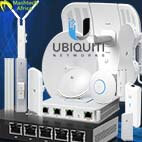TELTONIKA Dual SIM LTE Cat4 Industrial Cellular Wi-Fi4 Router (RUT901)
10 in stock
The RUT901 cellular router delivers the top-rated features of its predecessors, the RUT950 and RUT951, to the market.
The router features dual SIM 4G cellular connectivity and Wi-Fi, as well as 4x Ethernet interfaces, to meet the needs of the many varied IoT solutions.
The device ensures high-performance, providing automatic WAN failover to an available backup connection, guaranteeing network continuity, and eliminating downtime.
The RUT901 is dedicated to professional industrial use cases with its high customization possibilities, security features, industrial protocols, and compatibility with Teltonika Networks’ Remote Management System (RMS).
$156.45
10 in stock
CompareThe RUT901 cellular router delivers the top-rated features of its predecessors, the RUT950 and RUT951, to the market.
The router features dual SIM 4G cellular connectivity and Wi-Fi, as well as 4x Ethernet interfaces, to meet the needs of the many varied IoT solutions.
The device ensures high-performance, providing automatic WAN failover to an available backup connection, guaranteeing network continuity, and eliminating downtime.
The RUT901 is dedicated to professional industrial use cases with its high customization possibilities, security features, industrial protocols, and compatibility with Teltonika Networks’ Remote Management System (RMS).
| Brands | Teltonika |
|---|
Mobile
Mobile module: 4G LTE Cat 4 up to 150 DL/50 UL Mbps; 3G up to 21 DL/5.76 UL Mbps; 2G up to 236.8 DL/236.8 UL kbps
3GPP Release: Release 9
SIM switch: 2 SIM cards, auto-switch cases: weak signal, data limit, SMS limit, roaming, no network, network denied, data connection fail, SIM idle protection
Status: IMSI, ICCID, operator, operator state, data connection state, network type, bandwidth, connected band, signal strength (RSSI), SINR, RSRP, RSRQ, EC/IO, RSCP, data sent/received, LAC, TAC, cell ID, ARFCN, UARFCN, EARFCN, MCC, and MNC
SMS: SMS status, SMS configuration, send/read SMS via HTTP POST/GET, EMAIL to SMS, SMS to EMAIL, SMS to HTTP, SMS to SMS, scheduled SMS, SMS autoreply, SMPP
USSD: Supports sending and reading Unstructured Supplementary Service Data messages
Black/White list: Operator black/white list (by country or separate operators)
Multiple PDN: Possibility to use different PDNs for multiple network access and services
Band management: Band lock, Used band status display
SIM idle protection service: When working with devices with two SIM slots, the one not currently in use will remain idle until the device switches to it, meaning that no data is used on the card until then
APN: Auto APN
Bridge: Direct connection (bridge) between mobile ISP and device on LAN
Passthrough: Router assigns its mobile WAN IP address to another device on LAN
Wireless
Wireless mode: IEEE 802.11b/g/n, Access Point (AP), Station (STA)
Wi-Fi security: WPA2-Enterprise – PEAP, WPA2-PSK, WPA-EAP, WPA-PSK, WPA3-SAE, WPA3-EAP, OWE; AES-CCMP, TKIP, Auto-cipher modes, client separation, EAP-TLS with PKCS#12 certificates, disable auto-reconnect
SSID/ESSID: SSID stealth mode and access control based on MAC address
Wi-Fi users: Up to 100 simultaneous connections
Wireless Connectivity Features: Fast roaming (802.11r), Relayd, BSS transition management (802.11v), radio resource measurement (802.11k)
Wireless MAC filter: Whitelist, blacklist
Wireless QR code generator: Once scanned, a user will automatically enter your network without needing to input login information.
Ethernet
WAN: 1 x WAN port 10/100 Mbps, compliance IEEE 802.3, IEEE 802.3u, 802.3az standards, supports auto MDI/MDIX
LAN: 3 x LAN ports, 10/100 Mbps, compliance IEEE 802.3, IEEE 802.3u standards, supports auto MDI/MDIX
Network
Routing: Static routing, Dynamic routing (BGP, OSPF v2, RIP v1/v2, EIGRP, NHRP), Policy based routing
Network protocols: TCP, UDP, IPv4, IPv6, ICMP, NTP, DNS, HTTP, HTTPS, SFTP, FTP, SMTP, SSL/TLS, ARP, VRRP, PPP, PPPoE, UPNP, SSH, DHCP, Telnet, SMPP, SNMP, MQTT, Wake On Lan (WOL)
VoIP passthrough support: H.323 and SIP-alg protocol NAT helpers, allowing proper routing of VoIP packets
Connection monitoring: Ping Reboot, Wget Reboot, Periodic Reboot, LCP and ICMP for link inspection
Firewall: Port forward, traffic rules, custom rules
Firewall status page: View all your Firewall statistics, rules, and rule counters
Ports management: View device ports, enable and disable each of them, turn auto-configuration on or off, change their transmission speed, and so on
Network topology: Visual representation of your network, showing which devices are connected to which other devices
Hotspot: Captive portal (hotspot), internal/external Radius server, Radius MAC authentication, SMS authorisation, internal/external landing page, walled garden, user scripts, URL parameters, user groups, individual user or group limitations, user management, 9 default customisable themes and optionality to upload and download customised hotspot themes
DHCP: Static and dynamic IP allocation, DHCP relay, DHCP server configuration, status, static leases: MAC with wildcards
QoS / Smart Queue Management (SQM): Traffic priority queuing by source/destination, service, protocol or port, WMM, 802.11e
DDNS: Supported >25 service providers, others can be configured manually
Network backup: Wi-Fi WAN, Mobile, VRRP, Wired options, each of which can be used as an automatic Failover
Load balancing: Balance Internet traffic over multiple WAN connections
SSHFS: Possibility to mount remote file system via SSH protocol (not available in standard FW)
Security
Authentication: Pre-shared key, digital certificates, X.509 certificates, TACACS+, Radius, IP & login attempts block, time-based login blocking, built-in random password generator
Firewall: Pre-configured firewall rules can be enabled via WebUI, unlimited firewall configuration via CLI; DMZ; NAT; NAT-T
Attack prevention: DDOS prevention (SYN flood protection, SSH attack prevention, HTTP/HTTPS attack prevention), port scan prevention (SYN-FIN, SYN-RST, X-mas, NULL flags, FIN scan attacks)
VLAN: Port and tag-based VLAN separation
Mobile quota control: Mobile data limit, customizable period, start time, warning limit, phone number
WEB filter: Blacklist for blocking out unwanted websites, Whitelist for specifying allowed sites only
Access control: Flexible access control of SSH, Web interface, CLI and Telnet
VPN
OpenVPN: Multiple clients and a server can run simultaneously, 27 encryption methods
OpenVPN Encryption: DES-CBC 64, RC2-CBC 128, DES-EDE-CBC 128, DES-EDE3-CBC 192, DESX-CBC 192, BF-CBC 128, RC2-40-CBC 40, CAST5-CBC 128, RC2-64-CBC 64, AES-128-CBC 128, AES-128-CFB 128, AES-128-CFB1 128, AES-128-CFB8 128, AES-128-OFB 128, AES-128-GCM 128, AES-192-CFB 192, AES-192-CFB1 192, AES-192-CFB8 192, AES-192-OFB 192, AES-192-CBC 192, AES-192-GCM 192, AES-256-GCM 256, AES-256-CFB 256, AES-256-CFB1 256, AES-256-CFB8 256, AES-256-OFB 256, AES-256-CBC 256
IPsec: IKEv1, IKEv2, with 14 encryption methods for IPsec (3DES, DES, AES128, AES192, AES256, AES128GCM8, AES192GCM8, AES256GCM8, AES128GCM12, AES192GCM12, AES256GCM12, AES128GCM16, AES192GCM16, AES256GCM16)
GRE: GRE tunnel, GRE tunnel over IPsec support
PPTP, L2TP: Client/Server instances can run simultaneously, L2TPv3, L2TP over IPsec support
Stunnel: Proxy designed to add TLS encryption functionality to existing clients and servers without any changes in the program’s code
DMVPN: Method of building scalable IPsec VPNs
SSTP: SSTP client instance support
ZeroTier: ZeroTier VPN client support
WireGuard: WireGuard VPN client and server support
Tinc: Tinc offers encryption, authentication and compression in it’s tunnels. Client and server support.
MODBUS
Supported modes: Server, Client
Supported connection types: TCP
Custom registers: MODBUS TCP custom register block requests, which read/write to a file inside the router, and can be used to extend MODBUS TCP Client functionality
Supported data formats: 8-bit: INT, UINT; 16-bit: INT, UINT (MSB or LSB first); 32-bit: float, INT, UINT (ABCD (big-endian), DCBA (little-endian), CDAB, BADC), HEX, ASCII
DATA TO SERVER
Protocol: HTTP(S), MQTT, Azure MQTT, Kinesis
Data to server: Extract parameters from multiple sources and different protocols, and send them all to a single server
MQTT Gateway
Modbus MQTT Gateway: Allows sending commands and receiving data from MODBUS Server through MQTT broker
DNP3
Supported modes: Station, Outstation
Supported connection: TCP
DLMS
DLMS Support: DLMS – standard protocol for utility meter data exchange
Supported modes: Client
Supported connection types: TCP
API
Teltonika Networks Web API (beta) support: Expand your device’s possibilities by using a set of configurable API endpoints to retrieve or change data. For more information, please refer to this documentation: https://developers.teltonika-networks.com
Monitoring & Management
WEB UI: HTTP/HTTPS, status, configuration, FW update, CLI, troubleshoot, multiple event log servers, firmware update availability notifications, event log, system log, kernel log, Internet status
FOTA: Firmware update from server, automatic notification
SSH: SSH (v1, v2)
SMS: SMS status, SMS configuration, send/read SMS via HTTP POST/GET
Call: Reboot, Status, Mobile data on/off, Output on/off, answer/hang-up with a timer, Wi-Fi on/off
TR-069: OpenACS, EasyCwmp, ACSLite, tGem, LibreACS, GenieACS, FreeACS, LibCWMP, Friendly tech, AVSystem
MQTT: MQTT Broker, MQTT publisher
SNMP: SNMP (v1, v2, v3), SNMP Trap
JSON-RPC: Management API over HTTP/HTTPS
RMS: Teltonika Remote Management System (RMS)
IoT Platforms
Cloud of Things: Allows monitoring of: Device data, Mobile data, Network info, Availability
ThingWorx: Allows monitoring of: WAN Type, WAN IP, Mobile Operator Name, Mobile Signal Strength, Mobile Network Type
Cumulocity: Allows monitoring of: Device Model, Revision and Serial Number, WAN Type and IP, Mobile Cell ID, ICCID, IMEI, Connection Type, Operator, Signal Strength
Azure IoT Hub: Can send device IP, Number of bytes send/received, Temperature, PIN count to Azure IoT Hub server
System Characteristics
CPU: Mediatek, 580 MHz, MIPS 24KEc
RAM: 128 MB, DDR2
FLASH storage: 16 MB, SPI Flash
Firmware / Configuration
WEB UI: Update FW from file, check FW on server, configuration profiles, configuration backup
FOTA: Update FW
RMS: Update FW/configuration for multiple devices at once
Keep settings: Update FW without losing current configuration
Factory settings reset: A full factory reset restores all system settings, including the IP address, PIN, and user data to the default manufacturer’s configuration
FIRMWARE CUSTOMISATION
Operating system: RutOS (OpenWrt based Linux OS)
Supported languages: Busybox shell, Lua, C, C++
Development tools: SDK package with build environment provided
GPL customization: You can create your own custom, branded firmware and web page application by changing colours, logos, and other elements in our firmware to fit your or your clients’ needs
Input / Output
Input: 1 x Digital Input, 0 – 6 V detected as logic low, 8 – 30 V detected as logic high
Output: 1 x Digital Output, Open collector output, max output 30 V, 300 mA
Events: Email, RMS, SMS
I/O juggler: Allows to set certain I/O conditions to initiate event
Power
Connector: 4-pin industrial DC power socket
Input voltage range: 9 – 30 VDC, reverse polarity protection; surge protection >31 VDC 10us max
PoE (passive): Passive PoE over spare pairs. Possibility to power up through LAN1 port, not compatible with IEEE802.3af, 802.3at and 802.3bt standards, Mode B, 9 – 30 VDC
Power consumption: < 2 W idle, < 7 W Max
Physical Interfaces
Ethernet: 4 x RJ45 ports, 10/100 Mbps
I/O’s: 1 x Digital Input, 1 x Digital Output on 4-pin power connector
Status LEDs: 1 x Bi-color connection status, 5 x Mobile connection strength, 4 x ETH status, 1 x Power
SIM: 2 x SIM slots (Mini SIM – 2FF), 1.8 V/3 V, external SIM holders, eSIM (Optional)
Power: 1 x 4-pin power connector
Antennas: 2 x SMA for LTE, 2 x RP-SMA for Wi-Fi antenna connectors
Reset: Reboot/User default reset/Factory reset button
Physical Specification
Casing material: Aluminium housing, plastic panels
Dimensions (W x H x D): 110 x 50 x 100 mm
Weight: 297 g
Mounting options: DIN rail, wall mount, flat surface (all require additional kit)
Operating Environment
Operating temperature: -40 °C to 75 °C
Operating humidity: 10% to 90% non-condensing
Ingress Protection Rating: IP30
Regulatory & Type Approvals
Regulatory: CE, UKCA, IMDA, Anatel, RCM, E-mark, ECE R118, CB, RoHS, REACH, NCC
EMC Emissions & Immunity
Standards:
EN 55032:2015 + A11:2020 + A1:2020
EN 55035:2017 + A11:2020
EN IEC 61000-3-2:2019 + A1:2021
EN 61000-3-3:2013 + A1:2019 + A2:2021
EN 301 489-1 V2.2.3
EN 301 489-17 V3.2.4
EN 301 489-52 V1.2.1
ESD: EN 61000-4-2:2009
Radiated Immunity: EN IEC 61000-4-3:2020
EFT: EN 61000-4-4:2012
Surge Immunity (AC Mains Power Port): EN 61000-4-5:2014 + A1:2017
CS: EN 61000-4-6:2014
DIP: EN 61000-4-11:2020
RF
Standards:
EN 300 328 V2.2.2
EN 301 511 V12.5.1
EN 301 908-1 V15.1.1
EN 301 908-2 V13.1.1
EN 301 908-13 V13.1.1
Performance Specifications
Standards:
CE: EN IEC 62368-1:2020 + A11:2020, EN IEC 62311:2020, EN 50665:2017
CB: IEC 62368-1:2018
RCM: AS/NZS 62368.1:2022
Package contains
- Router RUT901
- 9 W PSU
- 2x Mobile antennas (swivel, SMA male)
- 2x Wi-Fi antennas (swivel, RP-SMA male)
- Ethernet cable (1.5 m)
- SIM Adapter kit
- QSG (Quick Start Guide)
- Packaging box

























There are no reviews yet.